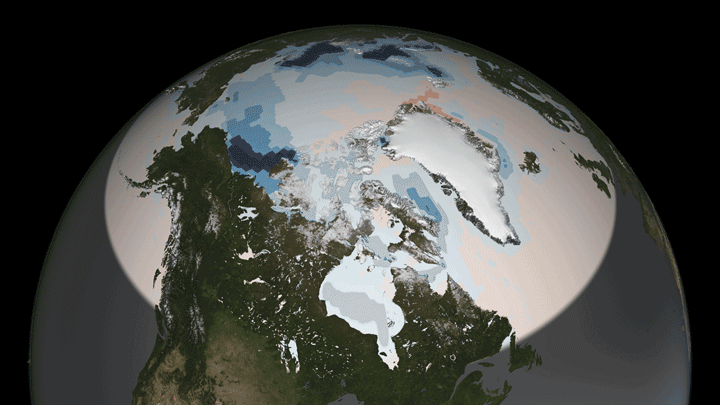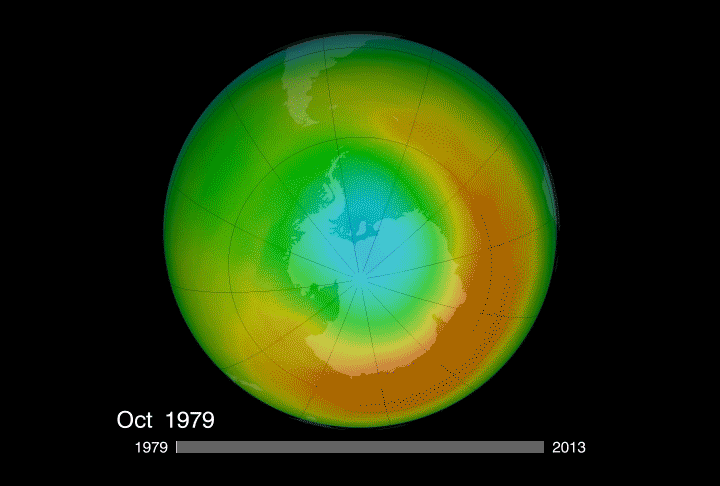News•December 25, 2014
The Year's 7 Most Telling Images From Space

By Brian Kahn
What’s better than a year-end list? A year-end list . . . from space.
As of July this year, there were 1,235 satellites in operation by countries around the world tracking everything from carbon dioxide to the weather. Throw in the International Space Station and you’ve got one heck of an Earth-observing system circling this fair planet.
The images and data from that system provides a perspective on the natural processes that shape the world and reveals the ways that humans are altering it. And they can make even everyday things look otherworldly. Like lightning. Lightning is even cooler from space.
RELATEDYou Should Watch This Space Time-lapse Right Now
The Year in Weather Like Never Seen Before
NASA Shows Stark Year in the Life of CO2
So with that in mind, here are the seven most telling images of the state of the Earth in 2014 as seen from beyond the atmosphere.
Plankton Colors the Sea
Credit: NASA Earth Observatory

Plankton blooms dot the world’s oceans throughout the year when iron mixes with fertile ocean currents and spawn little aquatic gardens. In early December, just such a bloom occurred off the southern tip of South America. The Suomi NPP satellite captured this iridescent brew of green plankton-rich water swirling amidst plain ol’ seawater.
These blooms have the potential to sequester carbon, and some scientists have floated the idea of seeding the ocean with iron to conjure up blooms that can draw down some of the extra carbon dioxide humans have been pumping into the atmosphere. What in theory is a good idea could have plenty of unintended consequences such as large ocean dead zones, so for now, we’re left to debate the pros and cons while checking out the natural version.
Dust in the Wind
Credit: NASA

In July, European Space Agency astronaut Alexander Gerst captured this view of dust stirred up in the dry valleys of northern Africa. That dust cannot only contribute to the aforementioned plankton blooms in the ocean but can be whisked across the Atlantic and inhibit hurricane activity, which happened in 2013, or even get carried all the way up to England, which happened in April 2014. Dust from parts of Canada could be a major contributor to Greenland’s ice melt in the future as well.
The Greenest Place on Earth
Credit: NASA Goddard Space Flight Center

If you’re in search of the greenest place in the world, look no further than the U.S. Corn Belt. No, not in terms of renewable energy (that would be Sweden) but rather plants. Corn and other plants cast a strong fluorescent glow that’s invisible to the naked eye, but it serves a bright signal to satellites that there’s a whole lot of growing going on.
The data scientists used to identify the Corn Belt as the world’s most productive region can also be a huge boon as food and water security become even more important in a warming world.
In 2012, the severe drought that gripped most of the nation combined with extremely high overnight temperatures to lower corn yields across the Corn Belt. That could be a harbinger of things to come: by 2100 U.S., rising temperatures could cause could corn production to drop as much as 84 percent according to a report this year looking at the economic impacts of climate change. And corn in the U.S. isn’t the only crop that’s likely to see a drop in production. Other crops such as wheat are also likely to suffer major declines globally.
Disappearing Ice on Land . . .
Credit: NASA Earth Observatory
The Yakutat Glacier in Alaska is one of the fastest retreating glaciers in the world. Landsat satellites have documented its retreat of more than 3 miles in the past 26 years. Some of that retreat is due to natural shifts at the end of the Little Ice Age period, but human caused climate change has helped hasten its disappearing act. According to NASA’s Earth Observatory, the average temperature in Yakutat has risen by about 3.3°F from 1948-2010 with a full quarter of that increase coming in the past 10 years.
The Yakutat is just one of many glaciers rapidly retreating. Climate change is helping cause most land ice to shrink, leading to major ecosystem shifts, contributing to sea level rise and increasing the odds of future water shortages.
. . . And On Sea
Credit: NASA

The Arctic continues to be the world’s fastest warming region, with temperatures increasing twice as fast there as they are on the rest of the planet. That heat has helped speed the decline of sea ice and increased the amount of the sun’s energy absorbed in the region.
Since 2000, NASA’s Aura and Aqua satellites have detected an increase in the amount of energy absorbed in the region, including a particularly large increase north of Alaska as shown in the GIF, as more dark sea water is exposed each year to the sun. Adding more heat to the Arctic could speed the demise of sea ice and trigger other potential feedbacks that could further alter the polar region.
Ozone Recovery Continues
Credit: NASA

If there’s one international agreement that gives climate negotiators hope, it’s the Montreal Protocol, an agreement set in 1987 to limit the amount of ozone-depleting chemicals used by humans every year, mostly as refrigerants.
Twenty-seven years later, the benefits of the agreement are starting to be seen in the progressive shrinking of the Antarctic ozone hole each year. This year’s recovery wasn’t a huge leap over last year, but it’s still trending in the right direction. NASA satellites and ground instruments are tracking these minute but important changes in the ozone layer, which is only about as thick as a credit card. And despite being stratospheric in nature, the ozone layer has direct impacts on the ground below it from limiting the level of ultraviolet radiation that reached the surface of the earth to even influencing wind patterns, and the extent of Antarctic sea ice.
Year of the #spacevine
One of the best parts about social media coming of age in an era where humans are constantly orbiting the planet is suddenly having near-instant access to their viewpoint and plenty of ways to share in it. Canadian astronaut Chris Hadfield revolutionized the use of social media in space during his stint aboard the International Space Station in 2013. Other astronauts have followed in his social media footsteps including Reid Wiseman, who spent more than 5 months in space.
One of the coolest things Wiseman sent back from space were 6-second Vine snippets of life and weather on Earth as seen from space, which he dubbed #spacevines. Of course only a small cadre of people will ever truly be able to say they Vined from space, but hopefully their results will be just as stunning as Wiseman’s.
You May Also Like:
Cheap Gas May Not Mean More Driving This Winter
You Should Watch This Space Time-lapse Right Now
Clues in Coral Hint at Looming Temperature Spike
Dreaming of a White Christmas? Check This Map